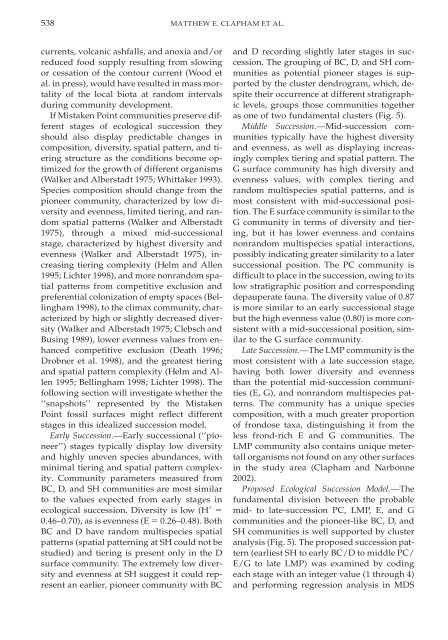Paleoecology of the oldest known animal communities: Ediacaran ...
Paleoecology of the oldest known animal communities: Ediacaran ...
Paleoecology of the oldest known animal communities: Ediacaran ...
You also want an ePaper? Increase the reach of your titles
YUMPU automatically turns print PDFs into web optimized ePapers that Google loves.
538 MATTHEW E. CLAPHAM ET AL.<br />
currents, volcanic ashfalls, and anoxia and/or<br />
reduced food supply resulting from slowing<br />
or cessation <strong>of</strong> <strong>the</strong> contour current (Wood et<br />
al. in press), would have resulted in mass mortality<br />
<strong>of</strong> <strong>the</strong> local biota at random intervals<br />
during community development.<br />
If Mistaken Point <strong>communities</strong> preserve different<br />
stages <strong>of</strong> ecological succession <strong>the</strong>y<br />
should also display predictable changes in<br />
composition, diversity, spatial pattern, and tiering<br />
structure as <strong>the</strong> conditions become optimized<br />
for <strong>the</strong> growth <strong>of</strong> different organisms<br />
(Walker and Alberstadt 1975; Whittaker 1993).<br />
Species composition should change from <strong>the</strong><br />
pioneer community, characterized by low diversity<br />
and evenness, limited tiering, and random<br />
spatial patterns (Walker and Alberstadt<br />
1975), through a mixed mid-successional<br />
stage, characterized by highest diversity and<br />
evenness (Walker and Alberstadt 1975), increasing<br />
tiering complexity (Helm and Allen<br />
1995; Lichter 1998), and more nonrandom spatial<br />
patterns from competitive exclusion and<br />
preferential colonization <strong>of</strong> empty spaces (Bellingham<br />
1998), to <strong>the</strong> climax community, characterized<br />
by high or slightly decreased diversity<br />
(Walker and Alberstadt 1975; Clebsch and<br />
Busing 1989), lower evenness values from enhanced<br />
competitive exclusion (Death 1996;<br />
Drobner et al. 1998), and <strong>the</strong> greatest tiering<br />
and spatial pattern complexity (Helm and Allen<br />
1995; Bellingham 1998; Lichter 1998). The<br />
following section will investigate whe<strong>the</strong>r <strong>the</strong><br />
‘‘snapshots’’ represented by <strong>the</strong> Mistaken<br />
Point fossil surfaces might reflect different<br />
stages in this idealized succession model.<br />
Early Succession. Early successional (‘‘pioneer’’)<br />
stages typically display low diversity<br />
and highly uneven species abundances, with<br />
minimal tiering and spatial pattern complexity.<br />
Community parameters measured from<br />
BC, D, and SH <strong>communities</strong> are most similar<br />
to <strong>the</strong> values expected from early stages in<br />
ecological succession. Diversity is low (H <br />
0.46–0.70), as is evenness (E 0.26–0.48). Both<br />
BC and D have random multispecies spatial<br />
patterns (spatial patterning at SH could not be<br />
studied) and tiering is present only in <strong>the</strong> D<br />
surface community. The extremely low diversity<br />
and evenness at SH suggest it could represent<br />
an earlier, pioneer community with BC<br />
and D recording slightly later stages in succession.<br />
The grouping <strong>of</strong> BC, D, and SH <strong>communities</strong><br />
as potential pioneer stages is supported<br />
by <strong>the</strong> cluster dendrogram, which, despite<br />
<strong>the</strong>ir occurrence at different stratigraphic<br />
levels, groups those <strong>communities</strong> toge<strong>the</strong>r<br />
as one <strong>of</strong> two fundamental clusters (Fig. 5).<br />
Middle Succession. Mid-succession <strong>communities</strong><br />
typically have <strong>the</strong> highest diversity<br />
and evenness, as well as displaying increasingly<br />
complex tiering and spatial pattern. The<br />
G surface community has high diversity and<br />
evenness values, with complex tiering and<br />
random multispecies spatial patterns, and is<br />
most consistent with mid-successional position.<br />
The E surface community is similar to <strong>the</strong><br />
G community in terms <strong>of</strong> diversity and tiering,<br />
but it has lower evenness and contains<br />
nonrandom multispecies spatial interactions,<br />
possibly indicating greater similarity to a later<br />
successional position. The PC community is<br />
difficult to place in <strong>the</strong> succession, owing to its<br />
low stratigraphic position and corresponding<br />
depauperate fauna. The diversity value <strong>of</strong> 0.87<br />
is more similar to an early successional stage<br />
but <strong>the</strong> high evenness value (0.80) is more consistent<br />
with a mid-successional position, similar<br />
to <strong>the</strong> G surface community.<br />
Late Succession. The LMP community is <strong>the</strong><br />
most consistent with a late succession stage,<br />
having both lower diversity and evenness<br />
than <strong>the</strong> potential mid-succession <strong>communities</strong><br />
(E, G), and nonrandom multispecies patterns.<br />
The community has a unique species<br />
composition, with a much greater proportion<br />
<strong>of</strong> frondose taxa, distinguishing it from <strong>the</strong><br />
less frond-rich E and G <strong>communities</strong>. The<br />
LMP community also contains unique metertall<br />
organisms not found on any o<strong>the</strong>r surfaces<br />
in <strong>the</strong> study area (Clapham and Narbonne<br />
2002).<br />
Proposed Ecological Succession Model. The<br />
fundamental division between <strong>the</strong> probable<br />
mid- to late-succession PC, LMP, E, and G<br />
<strong>communities</strong> and <strong>the</strong> pioneer-like BC, D, and<br />
SH <strong>communities</strong> is well supported by cluster<br />
analysis (Fig. 5). The proposed succession pattern<br />
(earliest SH to early BC/D to middle PC/<br />
E/G to late LMP) was examined by coding<br />
each stage with an integer value (1 through 4)<br />
and performing regression analysis in MDS

















